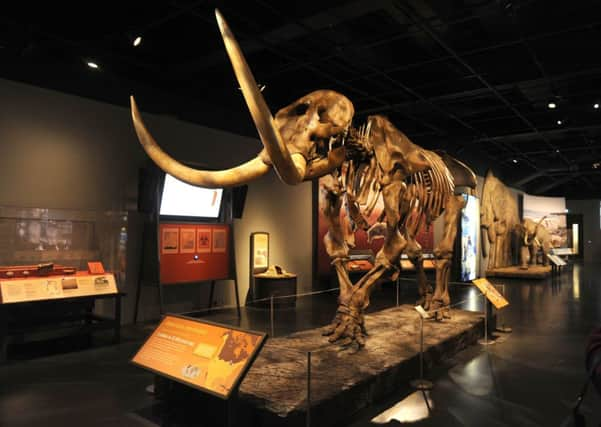National Museum of Scotland hosts ancient mammoths


Mysteries and myths surrounding mammoths and mastodons - some of which were the largest mammals to walk the planet - are tackled in the show which has taken over the major exhibition space at the National Museum of Scotland.
Fossils, casts and life-size models, as well as some of the oldest-surviving human art has been brought to the UK for the first time for the show, which was originally staged by the Field Museum of Natural History in Chicago, where it drew around 400,000 visitors when it was unveiled four years ago.
Advertisement
Hide AdThe exhibition, from museum collections around the world, offers the chance to delve deep into the world of the Ice Age, through the eyes of the great beasts that were able to survive the extreme temperatures.
The family trees of proboscideans - including mammoths, mastodons and elephants - are examined, along with the vast range and scale of the various creatures that could be found around in the world, living happily alongside humans.
Star attractions include a four-metre tall replica of a Columbian mammoth, the remains of the creature’s skull and tusks, fossils and prehistoric hunting tools collected by American president Thomas Jefferson.
There is also a full replica of “Lubya”, a 40,000 year-old baby mammoth discovered almost intact in Siberia seven years ago, and the cast of an almost-complete mastodon skeleton found in New York 14 years ago.
The exhibition explores the various conflicting theories why mammoths eventually died out, with the last of them surviving at Wrangel Island, in the Arctic Ocean. These include whether they were hunted out of existence or dramatically affected by climate change.
Visitors will also be able to learn about how mammoths and mastodons used their tusks and trunks, and coped with their vast weight, and the variations in their diets depending on the country they were in and the kind of teeth they had. Artwork on display, depicting mammoths in bone, stone and their own ivory dates from up to 35,000 years ago.
Advertisement
Hide AdThe show has taken over the exhibition space previously occupied by a major show charting the life and legacy of Mary Queen of Scots.
Dr Andrew Kitchener, principal curator of vertebrates at the museum, said: “The exhibition has toured around North America in the last few years but this is the first time it’s been anywhere in Europe, which is obviously very exciting for us.
Advertisement
Hide Ad“The exhibition has some spectacular specimens and reconstructions in it, it’s a very popular subject, and it has a lot for people to interact with.
“The quality of the exhibits is astonishing - you can just picture in your mind how big that creature was, especially beside some of the life-size reconstructions that we have.”
Jaap Hoogstraten, director of exhibitions at the Field Museum of Natural History, added: “The exhibition took around three years to put together and we had it for six months initially, when we had around 400,000 visitors and it’s been on tour since then.
“Mammoths just seem to resonate with people. They are big, charismatic, interesting animals with ancestors in elephants that still walk around.
“There’s not been another touring exhibition like this. Some of the pieces are just so big and beautiful and this is a unique opportunity for people to get to see them.”
Mammoths of the Ice Age is at the National Museum of Scotland until 20 April.